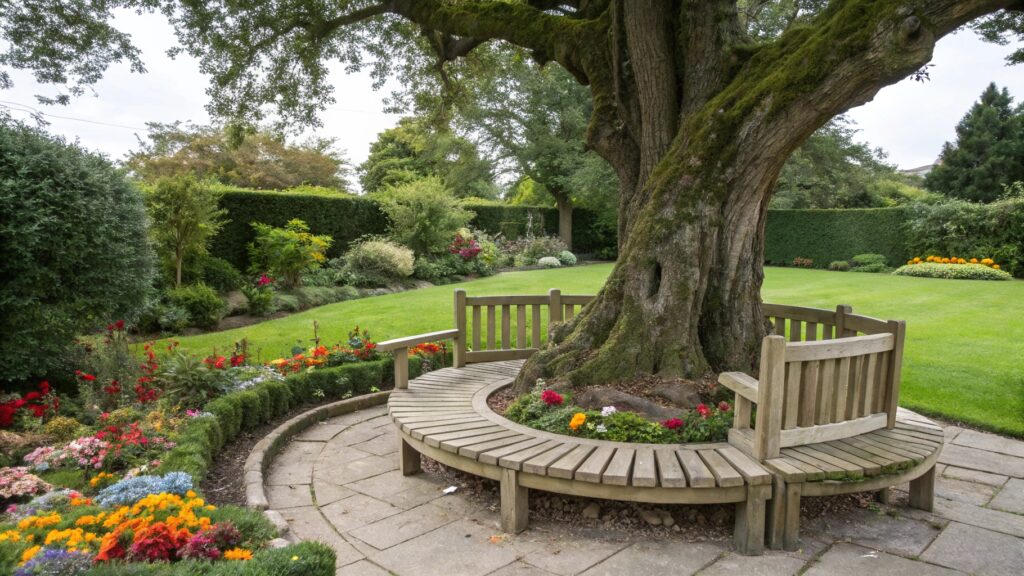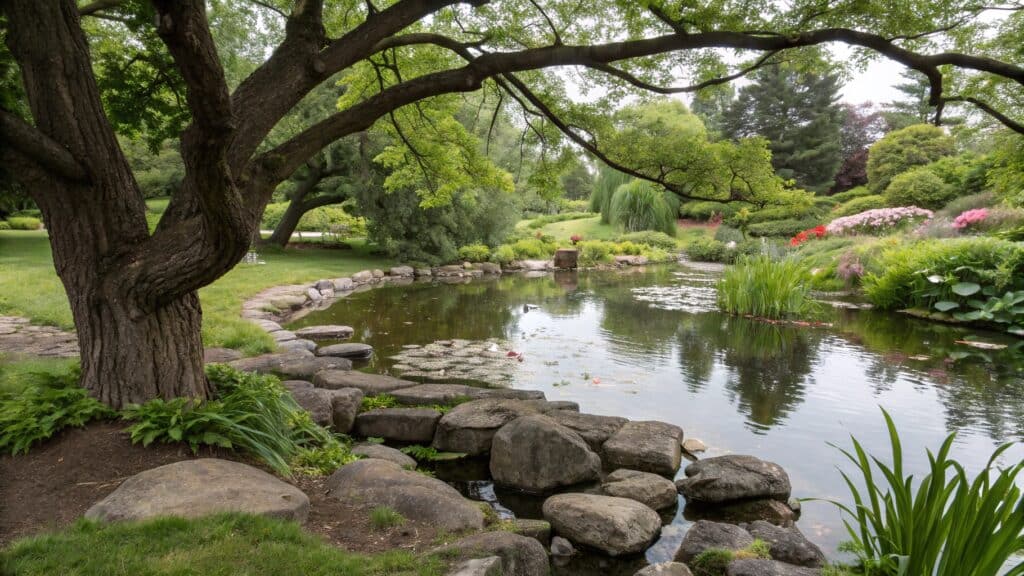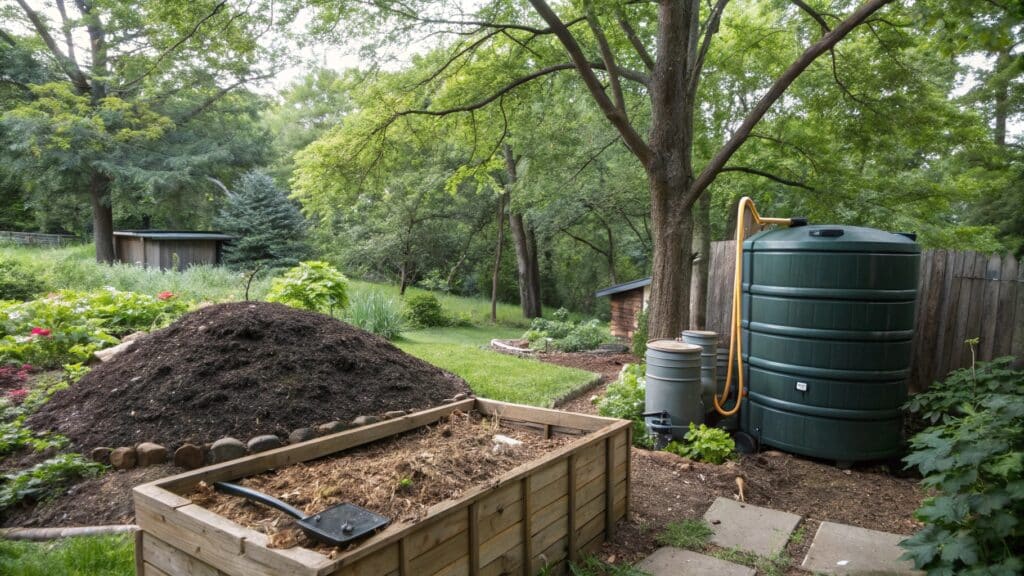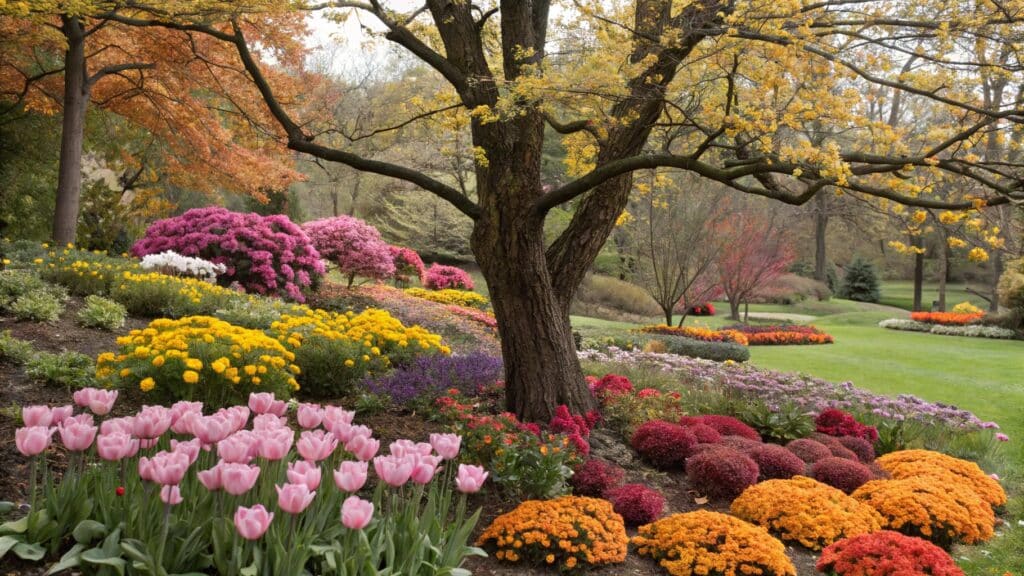Landscaping around trees can really change the look of your garden. It’s not just about making things look nice; it’s about keeping your trees healthy too. When you get it right, trees and plants can live together in harmony. But you have to think about things like the soil, the plants you choose, and how much water everything needs. With some clever ideas, you can turn your garden into a beautiful space that everyone will admire.
- Trees need space to grow, so don’t plant too close.
- Pick plants that like the shade of trees.
- Think about the soil around your trees before planting.
- Mulch can help keep the soil moist and healthy.
- Lighting can make your trees look great at night.
Table of Contents
Understanding the Basics of Landscaping Around Trees
Importance of Tree Health in Landscaping
When it comes to landscaping around trees, the health of the tree is absolutely vital. A healthy tree not only looks good but also supports the plants and features around it. Start by checking the tree for any signs of disease or damage. Regular pruning and proper watering can go a long way in maintaining its health.
Choosing the Right Plants for Underneath Trees
Picking the right plants to grow beneath your trees can be challenging. Opt for shade-loving plants like hostas or ferns that thrive without competing for nutrients. These choices can elevate your landscaping around trees, turning them into lush, green oases that enhance the beauty of your garden.
Soil Considerations for Tree-Surrounding Areas
The soil around your trees plays a big role in how well your landscaping efforts will turn out. Trees often have extensive root systems that can change the soil’s texture and nutrient levels. It’s important to test your soil and amend it if necessary. Adding organic matter can improve soil quality and help both the tree and surrounding plants flourish.
Remember, the key to successful landscaping around trees is balancing the needs of the tree with the aesthetic and practical goals you have for your garden. A little planning goes a long way in creating a beautiful and harmonious landscape.
Design Principles for Tree-Centric Landscapes
Designing landscaping around trees requires a thoughtful approach to enhance the tree’s natural beauty while creating a harmonious garden layout. Here are some key principles to inspire your design.
Creating Visual Harmony with Trees
Achieving visual harmony involves blending the tree’s natural form with the surrounding elements. Consider the tree’s size, shape, and color when selecting complementary plants and structures. Balance is key—too many elements can overwhelm the eye, while too few can leave the space feeling sparse.
Incorporating Trees into Garden Layouts
Integrating trees into your garden layout starts with acknowledging the tree trunk as a focal point. Arrange pathways, seating areas, and plant beds to draw attention to this natural centerpiece. A well-placed bench or a winding path can transform the space into a serene retreat.
Balancing Tree Canopy and Ground Cover
A tree’s canopy provides shade, but it also influences what grows beneath it. Choose ground covers that thrive in the shade and won’t compete with the tree’s roots for nutrients. Hostas, ferns, and shade-loving perennials can create a lush undergrowth without overburdening the soil.
Designing a garden around trees isn’t just about aesthetics; it’s about creating a space where nature and design coexist seamlessly. Every element should feel like it belongs, enhancing the beauty of the tree while offering a functional landscape.
Innovative Ideas for Landscaping Around Trees

Using Mulch and Ground Covers Effectively
When it comes to landscaping around trees, using mulch and ground covers can be a game-changer. Mulch is an essential element for creating landscapes around trees, as it helps retain moisture and enhances the aesthetic appeal of shaded areas.Instead, spread mulch evenly, keeping it away from the tree trunk. Ground covers like hostas or ferns can add texture and color beneath trees without competing for nutrients.
Integrating Water Features Near Trees

Water features can add a soothing element to your garden. Consider placing a small pond or a bubbling fountain near your trees. Ensure that the water feature is positioned so that it doesn’t disrupt the tree’s root system. This landscaping idea not only enhances aesthetics but also attracts wildlife.
Lighting Solutions to Highlight Tree Features
Proper lighting can transform your garden at night. Use uplights to accentuate the tree’s structure, or string lights for a more whimsical touch. Solar-powered options are eco-friendly and easy to install. Lighting draws attention to the natural beauty of your trees, making them focal points in your landscape.
Incorporating innovative elements like water features and lighting can truly elevate the beauty of your garden. They not only highlight the trees but also create a serene and inviting outdoor space.
Practical Tips for Maintaining Landscaping Around Trees
Pruning Techniques for Tree Health
Pruning is key to keeping your trees healthy and your garden looking neat. Regular pruning helps remove dead or diseased branches, which can prevent pests from making a home in your trees. When pruning, aim to cut branches that are smaller than two inches in diameter. This size is manageable and less likely to harm the tree. Remember, the goal is to maintain the tree’s natural shape while ensuring it stays healthy.
Watering Strategies for Tree-Surrounding Plants
Plants under trees need special watering strategies due to the tree’s canopy and root system. Try to water deeply but less frequently, ensuring the water reaches several inches of soil beneath the surface. This encourages roots to grow deeper, making plants more drought-resistant. Consider using a soaker hose for even coverage without wasting water.
Dealing with Pests and Diseases in Tree Areas
Managing pests and diseases around trees can be tricky but is necessary for a thriving garden. Start by regularly inspecting your trees and the surrounding plants for signs of trouble, such as discolored leaves or unusual growths. If you spot an issue, identify the pest or disease and choose a treatment method that targets the problem without harming beneficial insects. Sometimes, simple solutions like encouraging natural predators or using organic sprays can be effective.
Maintaining a landscape under a tree requires a balance between nurturing the tree and the plants below. With the right care, your garden can flourish beautifully, even in the shade of a majestic tree.
By following these tips, your landscaping under tree areas will not only look great but also support a healthy ecosystem. Remember, the key is consistency and observation.
Sustainable Practices in Tree Landscaping

Eco-Friendly Materials for Tree Landscaping
When it comes to sustainable landscaping, choosing the right materials is key. Organic mulch is one of the best options for maintaining moisture and adding nutrients to the soil. Unlike synthetic alternatives, organic mulch breaks down over time, enriching the soil with organic matter. Consider using eco-friendly tree care products like biodegradable mulches and organic fertilizers to further support a healthy tree environment.
Promoting Biodiversity Around Trees
Creating a diverse ecosystem around your trees can significantly benefit their health and the environment. Plant a variety of native plants and shrubs to attract beneficial insects and birds. Here are a few tips to boost biodiversity:
- Use a mix of flowering plants to attract pollinators.
- Incorporate different plant heights and textures for a layered effect.
- Avoid using pesticides that can harm wildlife.
Water Conservation Techniques for Tree Areas
Water is a precious resource, and conserving it is crucial in sustainable landscaping. Here are some strategies:
- Install drip irrigation systems to deliver water directly to the roots of your mature tree, reducing waste.
- Use rain barrels to collect and store rainwater for use during dry periods.
- Apply a layer of wood chip mulch around the base of your oak tree to retain soil moisture and reduce evaporation.
Sustainable tree landscaping not only benefits the environment but also enhances the beauty and longevity of your garden. By integrating these practices, you ensure a thriving ecosystem that supports both plant and animal life.
Enhancing Aesthetics with Tree Landscaping
Color Schemes for Tree-Centric Gardens
Creating a vibrant color scheme in your shade garden can transform your outdoor space into a visual masterpiece. Consider using plants with varied foliage colors to contrast with your trees. For example:
- Partial Shade Plants: Hostas, ferns, and heucheras offer beautiful foliage and thrive in partial shade.
- Flowering Options: Astilbes and foxgloves add pops of color without overwhelming the space.
- Evergreens: These provide year-round interest and structure.
Seasonal Planting Ideas Around Trees

To keep your garden lively throughout the year, think about seasonal planting. You can rotate plants to maintain interest in your landscape:
- Spring: Daffodils and tulips bring a burst of color.
- Summer: Introduce a succulent garden for texture and drought resistance.
- Autumn: Chrysanthemums and asters can add warmth as the leaves change.
Embracing the seasons allows your garden design to evolve, providing new surprises as the months pass.
Creating Focal Points with Trees
Trees can be more than just a backdrop; they can be stunning focal points in your garden. Use larger plant groupings or unique tree species to draw attention. Consider:
- Lighting: Subtle lighting can highlight a beautiful tree’s structure during nighttime.
- Water Features: Integrate a small pond or fountain near your tree for added interest.
- Mulch and Ground Covers: These not only reduce weed growth but also frame your trees beautifully.
By thoughtfully incorporating these elements, your garden can become a harmonious blend of nature and design, making it a perfect spot for relaxation and enjoyment. For more ideas on landscaping styles, explore different ways to enhance your garden’s aesthetic and functionality.
Common Mistakes to Avoid in Tree Landscaping
Overcrowding Plants Around Trees
A common error many make is planting too many shrubs or flowers around trees. This can lead to competition for water and nutrients, which might starve the tree and affect its growth. When planning your garden, ensure there’s enough space for both the tree and surrounding plants to thrive. Consider the mature size of all plants to avoid future problems.
Ignoring Tree Root Systems
Tree roots can spread far and wide, often extending beyond the canopy. Ignoring this can lead to significant issues. Roots need space to grow, and compacting the soil with heavy foot traffic or construction can damage them. Keep in mind that roots are vital for the tree’s stability and nutrient uptake.
Neglecting Long-Term Tree Growth
Planning for the present without considering the future is a mistake. Trees grow, and what fits today might not fit tomorrow. Think about the tree’s potential size and how it will interact with the garden layout over time. Regular trimming is important to prevent overgrowth and maintain the desired shape.
Proper planning and regular maintenance can prevent most tree landscaping issues. Consider the needs of both the tree and the plants around it to create a harmonious garden space.
Conclusion
Wrapping up, landscaping around trees can really change the look of your garden. It’s not just about making things pretty; it’s about creating a space that feels good to be in. Whether you’re adding flowers, rocks, or a little bench, each choice adds something special. Remember, it’s your garden, so let your style shine through. Don’t be afraid to try new things and see what works best for you. With a bit of effort and creativity, your garden can become a peaceful retreat right in your backyard.
Frequently Asked Questions
Why is it important to keep trees healthy when landscaping?
Healthy trees are the backbone of any garden. They provide shade, enhance air quality, and play a vital role in creating vibrant landscaping around trees. Maintaining their health ensures they continue to deliver these valuable benefits.
What types of plants grow well under trees?
Shade-loving plants, such as ferns and hostas, thrive in landscaping around trees. Their ability to flourish in low-light conditions makes them perfect for enhancing the beauty of tree-filled spaces.
How can I make sure the soil around trees is right for planting?
To ensure the soil supports thriving landscaping around trees, make sure it’s loose, well-drained, and nutrient-rich. Enhancing the soil with compost can boost its quality, benefiting both the tree and the surrounding plants.
What are some creative ideas for making my garden look nice around trees?
You can use mulch to keep the soil moist and add ground covers for a neat look. Adding small water features or lights can also make the area around trees more attractive.
How can I take care of the plants and trees in my garden?
Regularly prune the trees to keep them healthy, water the plants properly, and watch out for pests and diseases to keep your garden in good shape.
What mistakes should I avoid when landscaping around trees?
Avoid planting too many plants close to the tree, as it can harm both the plants and the tree. Also, be careful not to damage the tree roots while landscaping.
How can I improve my garden’s aesthetics?
Focusing on landscaping around trees can greatly enhance the overall aesthetics of your garden.


6 thoughts on “Landscaping Around Trees : Stunning Garden Ideas”